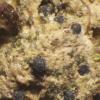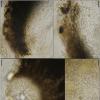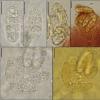
07-01-2026 10:24
 Danny Newman
Danny Newman
Pezicula sp. on indet. hardwood Appalachian Highl

07-01-2026 10:05
 Danny Newman
Danny Newman
cf. Chaetospermum on XylariaCosby Campground, Grea

02-01-2026 17:43
MARICEL PATINOHi there, although I couldn't see the fruitbody, I

04-01-2026 17:45
 Stephen Martin Mifsud
Stephen Martin Mifsud
I was happy to find these orange asmocyetes which

03-01-2026 13:08
Niek SchrierHi all,We found groups of perithecia on a Lecanora

29-12-2025 17:44
Isabelle CharissouBonjour,J'aimerais savoir si d'autres personnes au
Pyrenomycete on sandy soil
Gernot Friebes,
01-02-2011 07:42
a friend of mine found this pyrenomycete on sandy soil between mosses. We do not have any idea because we have never seen such a species before and we aren‘t even sure if this is a „true“ pyrenomycete or a lichenized species (there were algae all over the substrate). Here is the description:
Ascomata black, slightly immersed, smooth, ± spherical, with a minute, round ostiole. Asci clavate, short stipitate, 8-spored, sometimes thickwalled (truly bitunicate?), when old somehow loosing the structure, maybe even dissolving, no apical apparatus seen. Paraphyses not observed, hymenium is quite gelatinous and ± sharply delimitate in a crush preparation, turning conspicuously reddish in IKI; ascomatal wall two-layered, outer layer dark brown, carbonized, inner layer of hyaline, roundish cells; spores hyaline to slightly brownish when overmature, mature with three septa but when overmature also with an additional longitudinal septum, constricted at septa, wall smooth, 27-35 x 11-12 µm.
Best wishes,
Gernot
Gernot Friebes,
01-02-2011 07:45
Hans-Otto Baral,
01-02-2011 08:47

Re:Pyrenomycete on sandy soil
The IKI red reaction of the hymenial gelatine points to a relative of Capronia. That genus does not have any paraphysoids. Perhaps what looks like them on your photo are emptied asci with strongly swollen endotunica. What you can do is to test IKI after mounting in KOH for some seconds. Then I predict you will get a strong blue reaction.
I am unaware of a terricolous taxon in this group.
Zotto
Zotto
I am unaware of a terricolous taxon in this group.
Zotto
Zotto
Gernot Friebes,
02-02-2011 07:30
Re:Pyrenomycete on sandy soil
Hi Zotto,
I am not sure if the characters apart from the IKI reaction really fit for a relative of Capronia but I do not have enough experience to judge. Maybe the red reaction in IKI can be observed in some other groups than only in Capronia and related genera?
Melzer's reagent was negative and KOH+IKI was also red. Difficult fungus...
Best wishes,
Gernot
I am not sure if the characters apart from the IKI reaction really fit for a relative of Capronia but I do not have enough experience to judge. Maybe the red reaction in IKI can be observed in some other groups than only in Capronia and related genera?
Melzer's reagent was negative and KOH+IKI was also red. Difficult fungus...
Best wishes,
Gernot
Hans-Otto Baral,
02-02-2011 11:28

Re:Pyrenomycete on sandy soil
If you don't get the blue reaction then something is wrong. Did you ever pretreat with KOH for a blue reaction? When it is negative in Melzer then it should really turn blue after KOH. The KOH should perhaps be heated shortly (hold the slide for some seconds over a flame) although I would not expect that in this case. And afterwards a bit washed wioth water before adding IKI.
Apart from pyreno-lichens and bryophilous genera I know no representtive except for Capronia.
I cannot see a connection to a moss on your photo (f.ex. Epibryon has the red reaction).
Zotto
Zotto
Apart from pyreno-lichens and bryophilous genera I know no representtive except for Capronia.
I cannot see a connection to a moss on your photo (f.ex. Epibryon has the red reaction).
Zotto
Zotto
Gernot Friebes,
02-02-2011 21:23
Re:Pyrenomycete on sandy soil
I checked some ascomata again and I have to say that the reaction with IKI indeed is a bit strange. KOH+IKI without further pretreatment is still red but when I slightly heated KOH and washed with water the reaction shortly became green-red but after some time everything was red again. When now adding additional KOH by putting a drop next to the coverslip the hymenium bleaches from red to nearly hyaline and shows a distinctive green-bluish shade during bleaching out (see photo).
I also do not see a direct connection to mosses, I rather think it could be associated with algae but maybe neither of both is the case.
Best wishes,
Gernot
I also do not see a direct connection to mosses, I rather think it could be associated with algae but maybe neither of both is the case.
Best wishes,
Gernot
Hans-Otto Baral,
02-02-2011 21:30

Re:Pyrenomycete on sandy soil
That's really strange. I never saw such behaviour. I hope it does not depend on the person who does it :-/
The blue would be good, but it should be much stronger, and should apper when adding iodine, not when removing it. But maybe it is comparable to the Perrotia excipulum where rinsing with water intensified the blue reaction.
Zotto
The blue would be good, but it should be much stronger, and should apper when adding iodine, not when removing it. But maybe it is comparable to the Perrotia excipulum where rinsing with water intensified the blue reaction.
Zotto
Gernot Friebes,
02-02-2011 22:03
Re:Pyrenomycete on sandy soil
That is interesting because I made a preparation which desiccated after a while and when I rinsed water again, the blue-green reaction turned more intensively than before.
If we would use only Melzer's reagent we would not have so many problems with strange reactions. :@
Best wishes,
Gernot
If we would use only Melzer's reagent we would not have so many problems with strange reactions. :@
Best wishes,
Gernot
Hans-Otto Baral,
21-02-2011 22:21

Re:Pyrenomycete on sandy soil
Torsten Richter, the finder of this specimen, showed our images to P. Döbbeler, and he asked a lichenologist, Othmar Breuß. His answer was that this is a lichen with a very reduced thallus which is actually visible as small greenish particles on the soil around the perithecia. It fits Thelidium zwackhii apparently very well. The species is a member of Verricariaceae and occurs on various substrates such as stone, wood, sandy soil.
"Die Illustrationen Ihres Beleges passen sehr gut auf diese Art: Thallus sehr unscheinbar, oft nur in Spuren erkennbar. Perithecien fast aufsitzend, kugelig, mit (fast) durchgehend schwarzer Wand. Sporen 4-zellig und etwa 25-30 Mikron lang."
Zotto
"Die Illustrationen Ihres Beleges passen sehr gut auf diese Art: Thallus sehr unscheinbar, oft nur in Spuren erkennbar. Perithecien fast aufsitzend, kugelig, mit (fast) durchgehend schwarzer Wand. Sporen 4-zellig und etwa 25-30 Mikron lang."
Zotto








